Imigran 20Mg Nasal Spray
Package Leaflet: Information
for the User
What is in this leaflet
IMIGRAN® 20mg NASAL SPRAY
(sumatriptan)
Read all of this leaflet carefully before you start taking this medicine because it contains important information for you.
• Keep this leaflet. You may need to read it again.
• If you have any further questions, ask your doctor or pharmacist.
• This medicine has been prescribed for you only. Do not pass it on to others - it may harm them, even if their signs of illness are the same as yours.
• If you get any side effects, talk to your doctor or pharmacist. This includes any possible side effects not listed in this leaflet. See section 4.
The name of your medicine is IMIGRAN 20mg NASAL SPRAY, but it will be referred to as Imigran nasal spray or Imigran throughout this leaflet. This medicine is also available in another strength such as IMIGRAN 10mg NASAL SPRAY.
1 What Imigran nasal spray is and what it is used for
2 What you need to know before you use Imigran nasal spray
3 How to use Imigran nasal spray
4 Possible side effects
5 How to store Imigran nasal spray
6 Contents of the pack and other information
1 What Imigran nasal spray is and what it is used for
Each Imigran nasal spray contains a single dose of
sumatriptan, which belongs to a group of medicines called triptans (also known as 5-HT1 receptor agonists).
Imigran nasal spray is used to treat migraine headache.
Migraine symptoms may be caused by the temporary widening of blood vessels in the head. Imigran nasal spray is believed to reduce the widening of these blood vessels. This in turn helps to take away the headache and relieve other symptoms of a migraine attack, such as feeling or being sick (nausea or vomiting) and sensitivity to light and sound.
Don’t use Imigran nasal spray:
• If you’re allergic to
sumatriptan, or any of the other ingredients of this medicine (listed in section 6).
• If you have a heart problem such as narrowing of the arteries (Ischaemic heart disease) or chest pains (angina), or have already had a heart attack.
• If you have circulation problems in your legs that cause cramp-like pains when you walk (peripheral vascular disease).
• If you have had a stroke or
a mini-stroke (also called a transient ischaemic attack or TIA).
• If you have high blood pressure. You may be able to use Imigran nasal spray if your high blood pressure is mild and is being treated.
• If you have serious liver disease.
• With other migraine medicines, including those which contain ergotamine, or similar medicines such as methysergide or any triptan/ 5-HT1 receptor agonist (medicines which are also used for treating migraine).
• With anti-depressants called MAOIs (monoamine oxidase inhibitors), or if you have taken these medicines in the last 2 weeks.
If any of these apply to you:
^ Tell your doctor, and don’t use Imigran nasal spray.
Take special care with Imigran
Talk to your doctor or pharmacist before using Imigran.
If you have any extra risk factors
• If you are a heavy smoker,
or are using nicotine replacement therapy, and
especially
• If you are a man aged over
40, or
• If you are a woman who has been through the menopause.
In very rare cases, people have developed serious heart conditions after using Imigran, even though they had no signs of heart disease before. If any of the points above applies to you it could mean you have a greater risk of developing heart disease - so:
^ Tell your doctor so that your heart function can be checked before Imigran is prescribed for you.
If you have a history of fits
(seizures)
Or if you have other conditions which might make it more likely that you'll have a fit - for example, a head injury or alcoholism.
^ Tell your doctor so that you can be supervised more closely.
If you have liver or kidney disease
^ Tell your doctor so that you can be supervised more closely.
If you are allergic to antibiotics called sulphonamides
If so, you may also be allergic to Imigran. If you know you are allergic to an antibiotic but you are not sure whether it is a sulphonamide:
^ Tell your doctor or
pharmacist before using Imigran.
If you are taking antidepressants called SSRIs
(Selective Serotonin Reuptake Inhibitors) or SNRIs (Serotonin Noradrenaline Reuptake Inhibitors)
^ Tell your doctor or
pharmacist before using Imigran. Also see ‘Other medicines and Imigran’, below.
If you use Imigran frequently
Using Imigran too often may make your headaches worse.
^ Tell your doctor if this applies to you. He or she
may recommend you stop using Imigran.
If you feel pain or tightness in your chest after you use Imigran
These effects may be intense but they usually pass quickly. If they don't pass quickly, or they become severe:
^ Get medical help
immediately. Section 4 of this leaflet has more information about these possible side effects.
Other medicines and Imigran
Tell your doctor or pharmacist if you’re taking,
have recently taken or might take any other medicines. This includes any herbal products or medicines you've bought without a prescription.
Some medicines must not be taken with Imigran and others may cause adverse effects if they're taken with Imigran nasal spray. You must tell your doctor if you are taking:
• ergotamine also used to treat migraine, or similar medicines such as methysergide (see Section 2). Don't use Imigran at the same time as these medicines. Stop taking these medicines at least 24 hours before using Imigran nasal spray. Don't take any medicines which contain ergotamine or compounds similar to ergotamine again for at least 6 hours after using Imigran.
• other triptans/
5-HTi receptor agonists
(such as naratriptan, rizatriptan, zolmitriptan), also used to treat migraine, (see Section 2). Don't use Imigran at the same time as these medicines. Stop taking these medicines at least 24 hours before using Imigran.
Don't take another triptan/ 5-HT1 receptor agonist again for at least 24 hours after using Imigran.
• SSRIs (Selective Serotonin Reuptake Inhibitors) or SNRIs (Serotonin Noradrenaline Reuptake Inhibitors) used to treat depression.
Using Imigran with these medicines can cause serotonin syndrome (a collection of symptoms which can include restlessness, confusion, sweating, hallucinations, increased reflexes, muscle spasms, shivering, increased heart beat and shaking). Tell your doctor immediately if you are affected in this way.
• MAOIs (monoamine oxidase inhibitors) used to treat depression. Don't use Imigran if you have taken these in the last 2 weeks.
• St John’s Wort (Hypericum perforatum). Taking herbal remedies that contain St John's Wort while you are using Imigran nasal spray may make side effects more likely.
Pregnancy and breastfeeding
• If you are pregnant, think you may be pregnant or are planning to have a baby,
ask your doctor for advice before taking this medicine. There is only limited information about the safety of Imigran for pregnant women, though up untill now there is no evidence of any increased risk of birth defects. Your doctor will discuss with you whether or not you should use Imigran nasal spray while you are pregnant.
• Don’t breast-feed your baby for 12 hours after using Imigran. If you express any breast milk during this time, discard the milk and don't give it to your baby.
Driving and using machines
Either the symptoms of migraine or your medicine may make you drowsy. If you are affected, don’t drive or operate machinery.
Only use Imigran after your migraine headache begins
Don’t use Imigran to try to prevent an attack.
Always use this medicine exactly as your doctor has told you. Check with your doctor or pharmacist if you are not sure.
There’s a step-by-step guide
to using the spray at the end of this section.
How much to use
Adults aged 18 to 65
• The usual dose for adults aged 18 to 65 is one Imigran 20mg spray into just one nostril. But one Imigran 10mg spray into one nostril is enough for some people. Don't use more than two sprays in 24 hours.
Adolescents aged 12 to 17
• The usual dose for adolescents aged 12 to 17
is one Imigran 10mg spray into one nostril.
Children under 12
• Imigran nasal spray is not recommended for children under 12 years old.
Older people (aged over 65)
• Imigran nasal spray is not recommended for people aged over 65.
When to use Imigran nasal spray
• It’s best to use Imigran as soon as you feel a migraine coming on, although it can be used at any time during an attack.
If your symptoms start to come back
• You can use a second Imigran nasal spray after 2 hours, but don’t use more than two sprays in 24 hours.
If the first spray has no effect
^ Don’t use a second spray,
or any other Imigran preparation for the same attack. If Imigran nasal spray doesn't give you any relief:
^ Ask your doctor or pharmacist for advice.
If you use more Imigran than you should
• Don’t use more than two Imigran nasal sprays in 24 hours.
Using too much Imigran nasal spray could make you ill. If you have used more than two sprays in 24 hours:
^ Contact your doctor for advice.
If you have any further questions on the use of this medicine, ask your doctor or pharmacist.
Don't open a blister until you are ready to use a spray. Each spray is sealed in a blister to keep it clean and safe. If you carry a spray without a blister, or in an open blister, it may not work properly when you need it.
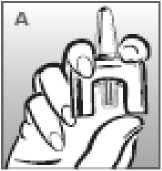
1
2
3
Remove the nasal spray from the blister packaging ju st before you want to use it.
Get into a co mfortable position. You may prefer to sit down.
Blow your n ose if it feels blocked, or if you have a cold.
Each spray contains just one dose of Imigran.
Don't press the plunger too soon or you will lose the dose.
4 Hold the nasal spray gently with your fingers and thumb, as shown in picture A. Don't press the blue plunger yet.
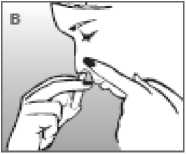
5 Block one nostril by pressing a finger firmly on the side of your nose. It doesn't matter which nostril you choose.
6 Put the nozzle of the nasal spray into the other nostril, as far as feels comfortable - about 1 cm or ^inch
(picture B).
Breathe out gently through your mouth.
Hold your he ad upright and close your mouth.
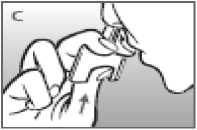
7
8
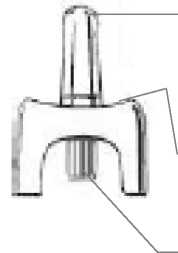
The part that you put into your nostril. The spray comes out of a tiny hole in the top.
The finger-g rip
Hold this when you use the spray.
The blue plu nger
Start to breathe in gently through your nose.
As you breat he in:
Press the bl ue plunger firmly with your thumb.
The plunger may feel a bit stiff and you may hear it c lick. Keep breathing in while spraying (picture C).
Remove the spray and remove your finger from the side of your nose.
Keep your head upright for 10-20 seconds, breathing gently in through your nose and out through your mouth. This helps the me dicine stay in your nose.
Your nose m ay feel wet inside and you may notice a slight taste after using the spray - this is normal and will soon pass. Your nasal spray is now empty. Throw it away safely and hygienically.
Press this to spray the whole dose into your nostril in one go.
This only works once - don't press the plunger until you have put the nozzle into your nostril or yo u will lose the dose.
Like all medicines, this medicine can cause side effects, but not everybody gets them.
Some symptoms may be caused by the migraine itself. Adverse events reported in adults have also been observed in adolescents.
These include very rare reports of heart attacks.
Allergic reaction: get doctor's help straight away
The following side effects have occurred but their frequency is not known.
• The signs of allergy include rash, hives (itchy rash); wheezing; swollen eyelids, face or lips; complete collapse.
If you get any of these symptoms soon after using Imigran nasal spray:
^ Don't use any more. Contact a doctor straight away.
Very common side effects
(affect more than 1 in 10 people)
• Unpleasant taste.
Common side effects
(affect up to 1 in 10 people)
• Heaviness, pressure, tightness or pain in the chest, throat or other parts of the body, or feelings of unusual sensations, including numbness, tingling and warmth or cold. These effects may be intense but generally pass quickly.
If these effects continue or become severe (especially the chest pain):
^ Get medical help urgently.
In a very small number of people these symptoms can be caused by a heart attack.
Other common side effects include:
• Irritation or burning sensation in the nose or throat; nose bleeds.
• Feeling sick (nausea) or being sick (vomiting), although this may be due to the migraine itself.
• Tiredness or drowsiness.
• Dizziness, feeling weak, or getting hot flushes.
• Temporary increase in blood pressure.
• Shortness of breath.
• Aching muscles.
Very rare side effects
(affect up to 1 in 10,000 people)
• Liver function changes. If you have a blood test to check your liver function, tell your doctor or nurse that you are using Imigran.
Some patients may have the following side effects but it is not known how often they occur
• Seizures/fits, tremors, muscle spasm, neck stiffness.
• Visual disturbances such as flickering, reduced vision, double vision, loss of vision and in some cases even permanent defects (although these may be due to the migraine attack itself).
• Heart problems, where your heart beat may go faster, slower or change rhythm, chest pains (angina) or heart attack.
• Pale blue-tinged skin and/or pain in your fingers, toes, ears, nose or jaw in response to cold or stress (Raynaud’s phenomenon).
• Feeling faint (blood pressure may go down).
• Pain in the lower left side of the stomach and bloody diarrhoea (ischaemic colitis).
• Diarrhoea.
• Pain in the joints.
• Feeling anxious.
• Excessive sweating.
Reporting of side effects
If you get any side effects, talk to your doctor, pharmacist or nurse. This includes any possible side effects not listed in this leaflet. You can also report side effects directly via the Yellow Card Scheme at: www.mhra.gov.uk/yellowcard. By reporting side effects, you can help provide more information on the safety of this medicine.
Keep out of the sight and reach of children.
Do not store above 30°C. Do not freeze.
Store in original pack in order to protect from light.
Do not use your Imigran nasal spray after the expiry date which is stated on the carton and packet label after 'Exp'.
The expiry date refers to the last day of that month.
Medicines should not be disposed of via wastewater or household waste. Ask your pharmacist how to dispose of medicines no longer required. These measures will help to protect the environment.
What Imigran nasal spray contains
Each pre-filled nasal spray contains 20mg of sumatriptan as the active ingredient in 0.1 ml of yellow-coloured aqueous solution.
The other ingredients are
potassium dihydrogen phosphate, anhydrous dibasic sodium phosphate, sulphuric acid, sodium hydroxide and purified water.
What Imigran nasal spray looks like and contents of the pack
Each pack contains 2 single dose nasal sprays in grey plastic with blue pump containing solution for nasal inhalation.
Manufactured by:
GlaxoSmithKline Manufacturing S.p.A., Strada Provinciale Asolana n.90, San Polo di Torrile (Parma), Italy.
Procured from within the EU and repackaged by the Product Licence holder:
B&S Healthcare, Unit 4, Bradfield Road, Ruislip, Middlesex, HA4 0NU, UK.
Leaflet date: 29.03.2016
IMIGRAN NASAL SPRAY and the IMIGRAN NASAL SPRAY logo are registered trademarks of the GlaxoSmithKline group of companies.
2. What you need to know before you use Sumatriptan nasal spray 3 How to use Sumatriptan nasal spray
SUMATRIPTAN
20mg
NASAL SPRAY
(sumatriptan)
Read all of this leaflet carefully before you start taking this medicine because it contains important information for you.
• Keep this leaflet. You may need to read it again.
• If you have any further questions, ask your doctor or pharmacist.
• This medicine has been prescribed for you only. Do not pass it on to others - it may harm them, even if their signs of illness are the same as yours.
• If you get any side effects, talk to your doctor or pharmacist. This includes any possible side effects not listed in this leaflet. See section 4.
The name of your medicine is SUMATRIPTAN 20mg NASAL SPRAY, but it will be referred to as Sumatriptan nasal spray or Sumatriptan throughout this leaflet. This medicine is also available in another strength such as SUMATRIPTAN 10mg NASAL SPRAY.
What is in this leaflet
1 What Sumatriptan nasal spray is and what it is used for
2 What you need to know before you use Sumatriptan nasal spray
3 How to use Sumatriptan nasal spray
4 Possible side effects
5 How to store Sumatriptan nasal spray
6 Contents of the pack and other information
1 What Sumatriptan nasal spray is and what it is used for
Each Sumatriptan nasal spray contains a single dose
of sumatriptan, which belongs to a group of medicines called triptans (also known as 5-HT1 receptor agonists).
Sumatriptan nasal spray is used to treat migraine headache.
Migraine symptoms may be caused by the temporary widening of blood vessels in the head. Sumatriptan nasal spray is believed to reduce the widening of these blood vessels. This in turn helps to take away the headache and relieve other symptoms of a migraine attack, such as feeling or being sick (nausea or vomiting) and sensitivity to light and sound.
Don’t use Sumatriptan nasal spray:
• If you’re allergic to
sumatriptan, or any of the other ingredients of this medicine (listed in section 6).
• If you have a heart problem such as narrowing of the arteries (Ischaemic heart disease) or chest pains (angina), or have already had a heart attack.
• If you have circulation problems in your legs that cause cramp-like pains when you walk (peripheral vascular disease).
• If you have had a stroke or
a mini-stroke (also called a transient ischaemic attack or TIA).
• If you have high blood pressure. You may be able to use Sumatriptan nasal spray if your high blood pressure is mild and is being treated.
• If you have serious liver disease.
• With other migraine medicines, including those which contain ergotamine, or similar medicines such as methysergide or any triptan/ 5-HT1 receptor agonist (medicines which are also used for treating migraine).
• With anti-depressants called MAOIs (monoamine oxidase inhibitors), or if you have taken these medicines in the last 2 weeks.
If any of these apply to you:
^ Tell your doctor, and don’t use Sumatriptan nasal spray.
Take special care with Sumatriptan
Talk to your doctor or pharmacist before using Sumatriptan.
If you have any extra risk factors
• If you are a heavy smoker,
or are using nicotine replacement therapy, and
especially
• If you are a man aged over
40, or
• If you are a woman who has been through the menopause.
In very rare cases, people have developed serious heart conditions after using Sumatriptan, even though they had no signs of heart disease before. If any of the points above applies to you it could mean you have a greater risk of developing heart disease - so: ^ Tell your doctor so that your heart function can be checked before Sumatriptan is prescribed for you.
If you have a history of fits
(seizures)
Or if you have other conditions which might make it more likely that you'll have a fit - for example, a head injury or alcoholism.
^ Tell your doctor so that you can be supervised more closely.
If you have liver or kidney disease
^ Tell your doctor so that you can be supervised more closely.
If you are allergic to antibiotics called sulphonamides
If so, you may also be allergic to Sumatriptan. If you know you are allergic to an antibiotic but you are not sure whether it is a sulphonamide:
^ Tell your doctor or
pharmacist before using Sumatriptan.
If you are taking antidepressants called SSRIs
(Selective Serotonin Reuptake Inhibitors) or SNRIs (Serotonin Noradrenaline Reuptake Inhibitors)
^ Tell your doctor or
pharmacist before using Sumatriptan. Also see ‘Other medicines and Sumatriptan’, below.
If you use Sumatriptan frequently
Using Sumatriptan too often may make your headaches worse.
^ Tell your doctor if this applies to you. He or she
may recommend you stop using Sumatriptan.
If you feel pain or tightness in your chest after you use Sumatriptan
These effects may be intense but they usually pass quickly. If they don't pass quickly, or they become severe:
^ Get medical help
immediately. Section 4 of this leaflet has more information about these possible side effects.
Other medicines and Sumatriptan
Tell your doctor or pharmacist if you’re taking,
have recently taken or might take any other medicines. This includes any herbal products or medicines you've bought without a prescription.
Some medicines must not be taken with Sumatriptan and others may cause adverse effects if they're taken with Sumatriptan nasal spray. You must tell your doctor if you are taking:
• ergotamine also used to treat migraine, or similar medicines such as methysergide (see Section 2). Don't use Sumatriptan at the same time as these medicines. Stop taking these medicines at least 24 hours before using Sumatriptan nasal spray. Don't take any medicines which contain ergotamine or compounds similar to ergotamine again for at least 6 hours after using Sumatriptan.
• other triptans/
5-HTi receptor agonists (such as naratriptan, rizatriptan, zolmitriptan), also used to treat migraine, (see Section 2). Don't use Sumatriptan at the same time as these medicines. Stop taking these medicines at least 24 hours before using Sumatriptan.
Don't take another triptan/ 5-HT1 receptor agonist again for at least 24 hours after using Sumatriptan.
• SSRIs (Selective Serotonin Reuptake Inhibitors) or SNRIs (Serotonin Noradrenaline Reuptake Inhibitors) used to treat depression.
Using Sumatriptan with these medicines can cause serotonin syndrome (a collection of symptoms which can include restlessness, confusion, sweating, hallucinations, increased reflexes, muscle spasms, shivering, increased heart beat and shaking). Tell your doctor immediately if you are affected in this way.
• MAOIs (monoamine oxidase inhibitors) used to treat depression. Don't use Sumatriptan if you have taken these in the last 2 weeks.
• St John’s Wort (Hypericum perforatum). Taking herbal remedies that contain St John's Wort while you are using Sumatriptan nasal spray may make side effects more likely.
Pregnancy and breastfeeding
• If you are pregnant, think you may be pregnant or are planning to have a baby,
ask your doctor for advice before taking this medicine. There is only limited information about the safety of Sumatriptan for pregnant women, though up untill now there is no evidence of any increased risk of birth defects. Your doctor will discuss with you whether or not you should use Sumatriptan nasal spray while you are pregnant.
• Don’t breast-feed your baby for 12 hours after using Sumatriptan. If you express any breast milk during this time, discard the milk and don't give it to your baby.
Driving and using machines
Either the symptoms of migraine or your medicine may make you drowsy. If you are affected, don’t drive or operate machinery.
Only use Sumatriptan after your migraine headache begins
Don’t use Sumatriptan to try to prevent an attack.
Always use this medicine exactly as your doctor has told you. Check with your doctor or pharmacist if you are not sure.
There’s a step-by-step guide
to using the spray at the end of this section.
How much to use
Adults aged 18 to 65
• The usual dose for adults aged 18 to 65 is one
Sumatriptan 20mg spray into just one nostril. But one Sumatriptan 10mg spray into one nostril is enough for some people. Don't use more than two sprays in 24 hours.
Adolescents aged 12 to 17
• The usual dose for adolescents aged 12 to 17
is one Sumatriptan 10mg spray into one nostril.
Children under 12
• Sumatriptan nasal spray is not recommended for
children under 12 years old.
Older people (aged over 65)
• Sumatriptan nasal spray is not recommended for
people aged over 65.
When to use Sumatriptan nasal spray
• It’s best to use Sumatriptan as soon as you feel a migraine coming on,
although it can be used at any time during an attack.
If your symptoms start to come back
• You can use a second Sumatriptan nasal spray after 2 hours, but don’t use more than two sprays in 24 hours.
If the first spray has no effect
^ Don’t use a second spray,
or any other Sumatriptan preparation for the same attack. If Sumatriptan nasal spray doesn't give you any relief:
^ Ask your doctor or pharmacist for advice.
If you use more Sumatriptan than you should
• Don’t use more than two Sumatriptan nasal sprays in 24 hours.
Using too much Sumatriptan nasal spray could make you ill. If you have used more than two sprays in 24 hours: ^ Contact your doctor for advice.
If you have any further questions on the use of this medicine, ask your doctor or pharmacist.
Don't open a blister until you are ready to use a spray. Each spray is sealed in a blister to keep it clean and safe. If you carry a spray without a blister, or in an open blister, it may not work properly when you need it.
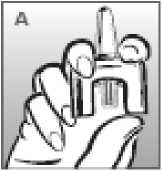
1
2
3
Remove the nasal spray from the blister packaging ju st before you want to use it.
Get into a co mfortable position. You may prefer to sit down.
Blow your n ose if it feels blocked, or if you have a cold.
Each spray contains just one dose of Imigran.
Don't press the plunger too soon or you will lose the dose.
4 Hold the nasal spray gently with your fingers and thumb, as shown in picture A. Don't press the blue plunger yet.
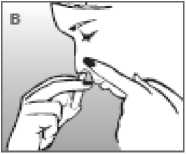
5 Block one nostril by pressing a finger firmly on the side of your nose. It doesn't matter which nostril you choose.
6 Put the nozzle of the nasal spray into the other nostril, as far as feels comfortable - about 1 cm or ^inch
(picture B).
Breathe out gently through your mouth.
Hold your he ad upright and close your mouth.
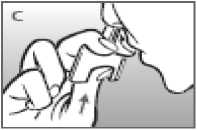
8
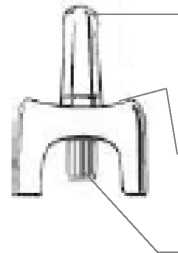
The part that you put into your nostril. The spray comes out of a tiny hole in the top.
The finger-g rip
Hold this when you use the spray.
The blue plu nger
Start to breathe in gently through your nose.
As you breat he in:
Press the bl ue plunger firmly with your thumb.
The plunger may feel a bit stiff and you may hear it c lick. Keep breathing in while spraying (picture C).
Remove the spray and remove your finger from the side of your nose.
Keep your head upright for 10-20 seconds, breathing gently in through your nose and out through your mouth. This helps the me dicine stay in your nose.
Your nose m ay feel wet inside and you may notice a slight taste after using the spray - this is normal and will soon pass. Your nasal spray is now empty. Throw it away safely and hygienically.
Press this to spray the whole dose into your nostril in one go.
This only works once - don't press the plunger until you have put the nozzle into your nostril or yo u will lose the dose.
Like all medicines, this medicine can cause side effects, but not everybody gets them.
Some symptoms may be caused by the migraine itself. Adverse events reported in adults have also been observed in adolescents.
These include very rare reports of heart attacks.
Allergic reaction: get doctor's help straight away
The following side effects have occurred but their frequency is not known.
• The signs of allergy include rash, hives (itchy rash); wheezing; swollen eyelids, face or lips; complete collapse.
If you get any of these symptoms soon after using Sumatriptan nasal spray:
^ Don't use any more. Contact a doctor straight away.
Very common side effects
(affect more than 1 in 10 people)
• Unpleasant taste.
Common side effects
(affect up to 1 in 10 people)
• Heaviness, pressure, tightness or pain in the chest, throat or other parts of the body, or feelings of unusual sensations, including numbness, tingling and warmth or cold. These effects may be intense but generally pass quickly.
If these effects continue or become severe (especially the chest pain):
^ Get medical help urgently.
In a very small number of people these symptoms can be caused by a heart attack.
Other common side effects include:
• Irritation or burning sensation in the nose or throat; nose bleeds.
• Feeling sick (nausea) or being sick (vomiting), although this may be due to the migraine itself.
• Tiredness or drowsiness.
• Dizziness, feeling weak, or getting hot flushes.
• Temporary increase in blood pressure.
• Shortness of breath.
• Aching muscles.
Very rare side effects
(affect up to 1 in 10,000 people)
• Liver function changes. If you have a blood test to check your liver function, tell your doctor or nurse that you are using Sumatriptan.
Some patients may have the following side effects but it is not known how often they occur
• Seizures/fits, tremors, muscle spasm, neck stiffness.
• Visual disturbances such as flickering, reduced vision, double vision, loss of vision and in some cases even permanent defects (although these may be due to the migraine attack itself).
• Heart problems, where your heart beat may go faster, slower or change rhythm, chest pains (angina) or heart attack.
• Pale blue-tinged skin and/or pain in your fingers, toes, ears, nose or jaw in response to cold or stress (Raynaud’s phenomenon).
• Feeling faint (blood pressure may go down).
• Pain in the lower left side of the stomach and bloody diarrhoea (ischaemic colitis).
• Diarrhoea.
• Pain in the joints.
• Feeling anxious.
• Excessive sweating.
Reporting of side effects
If you get any side effects, talk to your doctor, pharmacist or nurse. This includes any possible side effects not listed in this leaflet. You can also report side effects directly via the Yellow Card Scheme at: www.mhra.gov.uk/yellowcard. By reporting side effects, you can help provide more information on the safety of this medicine.
5 How to store Sumatriptan nasal spray
Keep out of the sight and reach of children.
Do not store above 30°C. Do not freeze.
Store in original pack in order to protect from light.
Do not use your Sumatriptan nasal spray after the expiry date which is stated on the carton and packet label after 'Exp'. The expiry date refers to the last day of that month.
Medicines should not be disposed of via wastewater or household waste. Ask your pharmacist how to dispose of medicines no longer required. These measures will help to protect the environment.
What Sumatriptan nasal spray contains
Each pre-filled nasal spray contains 20mg of sumatriptan as the active ingredient in 0.1 ml of yellow-coloured aqueous solution.
The other ingredients are
potassium dihydrogen phosphate, anhydrous dibasic sodium phosphate, sulphuric acid, sodium hydroxide and purified water.
What Sumatriptan nasal spray looks like and contents of the pack
Each pack contains 2 single dose nasal sprays in grey plastic with blue pump containing solution for nasal inhalation.
Manufactured by:
GlaxoSmithKline Manufacturing S.p.A., Strada Provinciale Asolana n.90, San Polo di Torrile (Parma), Italy.
Procured from within the EU and repackaged by the Product Licence holder:
B&S Healthcare, Unit 4, Bradfield Road, Ruislip, Middlesex, HA4 0NU, UK.
SUMATRIPTAN 20mg NASAL SPRAY
Leaflet date: 29.03.2016